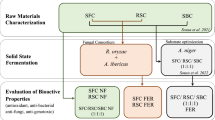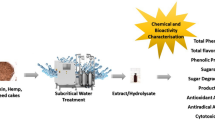Abstract
Jatropha seed cake, a byproduct after biodiesel extraction, has several anti-nutrients and toxins. Solid-state fermentation was carried out for the detoxification of the Jatropha seed cake (JSC) using different fungal cultures. The reduction in the anti-nutritional components such as tannins, phytates, saponins, lectin and protease inhibitor, and phorbol esters on 6th, 9th, and 12th day of fermentation was analyzed. The phorbol ester content in the unfermented JSC was 0.83 mg/g, and the maximum degradation of phorbol esters to the extent of 75 % was observed in the case of JSC fermented with Cunninghamella echinulata CJS-90. The phytate degradation in the fermented JSC was in the range of 65–96 %. There was a gradual reduction of saponin content in the JSC from 6th to 12th day, and the reduction of saponin was in the range of 55–99 % after solid-state fermentation. The trypsin inhibitor activity and lectin were 1,680 trypsin inhibitor units (TIU) per gram and 0.32 hemagglutinating unit in the unfermented JSC, respectively. Trypsin inhibitor activity and lectin could not be detected in JSC after 12th day of solid-state fermentation. Tannins accounted for 0.53 % in unfermented JSC, and there was a marginal increase of tannins after solid-state fermentation. The results indicate that biological detoxification could be a promising method to reduce anti-nutritional compounds and toxins in the JSC.





Similar content being viewed by others
References
Makkar, H. P. S., Aderibigbe, A. O., & Becker, K. (1998). Comparative evaluation of non-toxic and toxic varieties of Jatropha curcas for chemical composition, digestibility, protein degradability and toxic factors. Food Chemistry, 62, 207–215.
Antony Raja, S., Robinson Smart, D. S., & Lindon Robert Lee, C. (2011). Biodiesel production from Jatropha oil and its characterization. Research Journal of Chemical Sciences, 1, 81–87.
Zanzi, R., Perez, J.A.S., Soler, P.B. (2008). Production of biodiesel from Jatropha curcas in the region of Guantanamo in Cuba. Proc. 3rd International Congress University-Industry Cooperation, Ubatuba, Brazil.
Liang, Y., Siddaramu, T., Yesuf, J., & Sarkany, N. (2010). Fermentable sugar release from Jatropha seed cakes following lime pretreatment and enzymatic hydrolysis. Bioresource Technology, 101, 6417–6424.
Liberalino, A., Bambirra, E., Moraes Santos, T., & Vieira, E. (1988). Jatropha curcas L. seeds: Chemical analysis and toxicity. Arquivos De Biologia E Tecnologia, 31, 539–550.
Makkar, H. P. S., Francis, G., & Becker, K. (2008). Protein concentrate from Jatropha curcas screw pressed seed cake and toxic and anti-nutritional factors in protein concentrate. Journal of the Science Food and Agriculture, 88, 1542–1548.
Adam, S. E. I. (1974). Toxic effects of Jatropha curcas in mice. Toxicology, 2, 67–76.
Ahmed, O. M., & Adam, S. E. I. (1979). Effects of Jatropha curcas on calves. Veterinary Pathology, 16, 476–482.
Ahmed, O. M., & Adam, S. E. I. (1979). Toxicity of Jatropha curcas in sheep and goats. Research in Veterinary Science, 27, 89–96.
Mampane, K., Joubert, P., & Hay, I. (2006). Jatropha curcas: Use as a traditional Tswana medicine and its role as a cause of acute poisoning. Phytotherapy Research, 1, 50–51.
El Badwi, S. M. A., Mousa, H. M., Adam, S. E. I., & Hapke, H. J. (1992). Response of brown Hisex chicks to low levels of Jatropha curcas, Ricinus communis or their mixture. Veterinary and Human Toxicology, 34, 304–306.
Makkar, H. P. S., Becker, K., & Schmook, B. (1998). Edible provenances of Jatropha curcas from Quintna Roo state of Mexico and effect of roasting on anti-nutrient and toxic factors in seeds. Plant Foods for Human Nutrition, 52, 31–36.
Makkar, H., & Becker, K. (2009). Jatropha curcas, a promising crop for the generation of biodiesel and value-added coproducts. European Journal of Lipid Science and Technology, 111, 773–787.
Martinez-Herrera, J., Siddhuraju, P., Francis, G., Davila-Ortiz, G., & Becker, K. (2006). Chemical composition, toxic/antimetabolic constituents, and effects of different treatments on their levels, in four provenances of Jatropha curcas L. from Mexico. Food Chemistry, 96, 80–89.
Adolf, W., Opferkuch, H. J., & Hecker, E. (1984). Irritant phorbol derivatives from four Jatropha species. Phytochemistry, 23, 129–132.
Hirota, M., Suttajit, M., Suguri, H., Endo, Y., Shudo, K., Wonchai, V., et al. (1988). A new tumor promoter from the seed oil of Jatropha curcas L., an intramolecular diester of 12-deoxy-16-hydroyphorbol. Cancer Research, 48, 5800–5804.
Belewu, M. A., & Sam, R. (2010). Solid state fermentation of Jatropha curcas kernel cake: Proximate composition and anti-nutritional components. Journal of Yeast and Fungal Research, 1, 44–46.
Barros, C. R. M. D., Ferreira, L. M. M., Nunes, F. M., Bezerra, R. M. F., Dias, A. A., Guedes, C. V., et al. (2011). The potential of white rot fungi to degrade phorbol esters of Jatropha curcas L. seed cake. Engineering in Life Sciences, 11, 107–110.
Joshi, C., Mathur, P., & Khare, S. K. (2011). Degradation of phorbol esters by Pseudomonas aeruginosa PseA during solid-state fermentation of deoiled Jatropha seed cake. Bioresource Technology, 102, 4815–4819.
Oseni, O. A., & Akindahunsi, A. A. (2011). Some phytochemical properties and effect of fermentation on the seed of Jatropha curcas L. American Journal of Food Technology, 6, 158–165.
Makkar, H. P. S., Siddhuraju, P., & Becker, K. (2007). Plant secondary metabolites. In Methods in molecular biology (Vol. 393, pp. 23–28). Totowa: Humana.
Hiai, S., Oura, H., & Nakajima, T. (1976). Color reaction of some sapogenins and saponins with vanillin and sulfuric acid. Planta Medica, 29, 116–122.
Lis, H., & Sharon, N. (1972). Soyabean (Glycine max) haemoglutinin in complex carbonates. In S. P. Colowick & N. O. Kaplan (Eds.), Methods in enzymology, Vol. XXVIIIB (pp. 360–362). New York: Academic Press.
Benjakul, S., Wonnop, V., & Paiboon, T. (2000). Isolation and characterization of trypsin inhibitors from some Thai legume seeds. Journal of Food Biochemistry, 24, 107–127.
Lowry, O. H., Rosebrough, N. J., Farr, A. L., & Randall, R. J. (1951). Protein measurement with the Folin phenol reagent. Journal of Biological Chemistry, 193, 265–275.
Makkar, H. P. S., Becker, K., Sporer, F., & Wink, M. (1997). Studies on nutritive potential and toxic constituents of different provenances of Jatropha curcas. Journal of Agricultural and Food Chemistry, 45, 3152–3157.
Vogg, G., Achatz, S., Kettrup, A., & Sandermann, H., Jr. (1999). Fast, sensitive and selective liquid chromatographic tandem mass spectrometric determination of tumor promoting diterpene esters. Journal of Chromatography A, 855, 563–573.
Adam, S. E. I., & Magzoub, M. (1975). Toxicity of Jatropha curcas for goats. Toxicology, 4, 347–354.
Reddy, N. R., & Pierson, M. D. (1994). Reduction in anti-nutritional and toxic components in plant foods by fermentation. Food Research International, 27, 281–290.
Herlt, A. J., Mander, L. N., Pongoh, E., Rumampuk, R. J., & Tarigan, P. (2002). Two major saponins from seeds of Barringtonia asiatica: putative antifeedants toward Epilachna sp. larvae. Journal of Natural Products, 65, 115–120.
Cano Asseleih, L. M., Plumbley, R. A., & Hylands, P. J. (1989). Purification and partial characterization of the hemagglutinin from seeds of Jatropha curcas. Journal of Food Biochemistry, 13, 1–20.
Rawlings, N. D., & Barrett, A. J. (1994). In families of serine peptidases. Methods in Enzymology, 244, 19–61.
Hajos, G., Gelencser, E., Pusztai, A., Grant, G., Sakhri, M., & Bardocz, S. (1995). Biological effects and survival of trypsin inhibitors and agglutinin from soybean in the small intestine of the rat. Journal of Agricultural and Food Chemistry, 43, 165–170.
Arellano-González, M. A., Ramírez-Coronel, M. A., Torres-Mancera, M. T., Pérez-Morales, G. G., & Saucedo-Castañeda, G. (2011). Antioxidant activity of fermented and nonfermented coffee (Coffea arabica) pulp extracts. Food Technology and Biotechnology, 49, 374–378.
Acknowledgments
Authors gratefully acknowledge the financial grant provided by Ministry of Environment and Forests, New Delhi, India, for carrying out this research work. Authors thank Dr. M.S. Thakur, Dr. H.K. Manonmani, Scientists, FTBE Dept, and Prof. Ram Rajasekharan, Director, CSIR-CFTRI, Mysore for their encouragement and support.
Author information
Authors and Affiliations
Corresponding author
Rights and permissions
About this article
Cite this article
Sharath, B.S., Mohankumar, B.V. & Somashekar, D. Bio-detoxification of Phorbol Esters and Other Anti-nutrients of Jatropha curcas Seed Cake by Fungal Cultures Using Solid-State Fermentation. Appl Biochem Biotechnol 172, 2747–2757 (2014). https://doi.org/10.1007/s12010-013-0698-9
Received:
Accepted:
Published:
Issue Date:
DOI: https://doi.org/10.1007/s12010-013-0698-9




